Table of Contents
Moroccan Food Guide: Top Dishes You Must Try
A Warm Welcome to Moroccan Cuisine
Step into the vibrant world of Moroccan food, where every dish tells a story of tradition, flavor, and culture. Rooted in the rich history of Morocco, this cuisine is a harmonious blend of Berber, Arab, and Mediterranean influences. With its aromatic spices, fresh herbs, and diverse textures, Moroccan cuisine offers a sensory journey like no other. Whether savoring a slow-cooked tagine or enjoying the warmth of mint tea, each bite reveals a unique tapestry of flavors. Celebrated globally, Moroccan food exemplifies the art of hospitality, inviting everyone to experience the soul of Morocco through its unforgettable dishes.
Why Moroccan Food is Globally Celebrated
The global acclaim of Moroccan food lies in its unparalleled fusion of flavors, techniques, and history. Drawing from the diverse cultural tapestry of Morocco, it combines Berber simplicity, Arab sophistication, and Mediterranean freshness. Each dish, from the fragrant tagines to the vibrant couscous, showcases the mastery of spice blending and balance. The use of saffron, preserved lemons, and Moroccan olives adds a distinct depth, elevating every meal into an aromatic feast. Beyond the food itself, the culture of Morocco values hospitality, making dining a celebratory experience. This universal appeal ensures Moroccan food remains a cherished cuisine worldwide.
The Perfect Blend of Spices, Tradition, and Culture
Moroccan food is a symphony of spices, tradition, and culture, seamlessly woven into every dish. The culinary art of Morocco balances bold flavors like cumin, saffron, and cinnamon with the delicate sweetness of dried fruits. Rooted in centuries-old customs, Moroccan cuisine reflects the nation’s Berber, Arab, and Andalusian influences. Beyond flavor, it carries the essence of community and celebration. Each meal, from hearty tagines to fragrant couscous, represents the enduring spirit of Morocco and its vibrant cultural heritage.
The Rich History of Moroccan Cuisine
Influences from Berber, Arab, and French Cultures
Moroccan food is a captivating blend of diverse cultural influences. The Berber roots provide hearty staples like couscous and tagines, emphasizing simplicity and earthiness. Arab influences introduced vibrant spices, dried fruits, and the rich tradition of communal feasting. French colonization brought refined techniques, pastries, and a touch of elegance to Moroccan cuisine. Together, these elements create a culinary identity unique to Morocco, where every dish tells a story of heritage and harmony. This fusion makes Moroccan food both timeless and universally appealing.
The Role of Trade and the Spice Route in Shaping Flavors
The evolution of Moroccan food owes much to the ancient trade routes and the famed Spice Route. As a pivotal hub, Morocco welcomed spices like cinnamon, saffron, and turmeric from distant lands, enriching its culinary repertoire. These exotic ingredients merged seamlessly with native flavors, creating the distinctive taste of Moroccan cuisine. Trade also introduced almonds, apricots, and olives, now staples in iconic dishes. This confluence of global influences transformed Moroccan food into a flavorful reflection of history and cross-cultural exchange.
How Moroccan Food Reflects Its Diverse Heritage
Moroccan food is a vibrant tapestry that mirrors the diverse heritage of Morocco. Influenced by Berber ingenuity, Arab sophistication, and Mediterranean freshness, it showcases a rich cultural blend. Each dish, from spiced tagines to flaky pastilla, embodies centuries of history and migration. The interplay of bold spices, dried fruits, and aromatic herbs reveals the fusion of traditions that define Moroccan cuisine. This culinary diversity highlights Morocco’s unique ability to harmonize flavors from its varied cultural influences into unforgettable meals.
Essential Moroccan Ingredients
The Staples: Couscous, Olives, and Preserved Lemons
At the heart of Moroccan food lie its beloved staples: couscous, olives, and preserved lemons. Couscous, a time-honored grain, is a cornerstone of meals across Morocco, offering versatility and nourishment. Briny Moroccan olives add depth to dishes, while preserved lemons lend a tangy complexity that defines the cuisine. Together, they form the essence of Morocco’s culinary identity.
Signature Spices: Ras el Hanout, Cumin, and Saffron
Signature spices like Ras el Hanout, cumin, and saffron define the bold flavors of Moroccan food. Ras el Hanout, a complex blend of up to 30 spices, is the hallmark of Moroccan cooking, adding warmth and depth. Cumin, with its earthy, slightly nutty flavor, is essential in many dishes, from tagines to salads. Saffron, prized for its golden hue and floral notes, elevates Moroccan meals to new heights. These spices reflect the rich, aromatic essence of Morocco‘s culinary tradition.
Fresh Ingredients: Mint, Parsley, and Seasonal Vegetables
Fresh ingredients like mint, parsley, and seasonal vegetables are vital to the vibrancy of Moroccan food. Mint, often used in refreshing tea and savory dishes, imparts a cooling, aromatic quality. Parsley adds a burst of color and brightness, complementing the rich, spiced flavors of Moroccan cuisine. Seasonal vegetables, such as tomatoes, carrots, and zucchini, bring natural sweetness and texture, grounding the bold spices. Together, these fresh elements embody the essence of Morocco, enhancing both flavor and nutrition in every meal.
Must-Try Moroccan Dishes
Tagine: The Heart of Moroccan Cooking
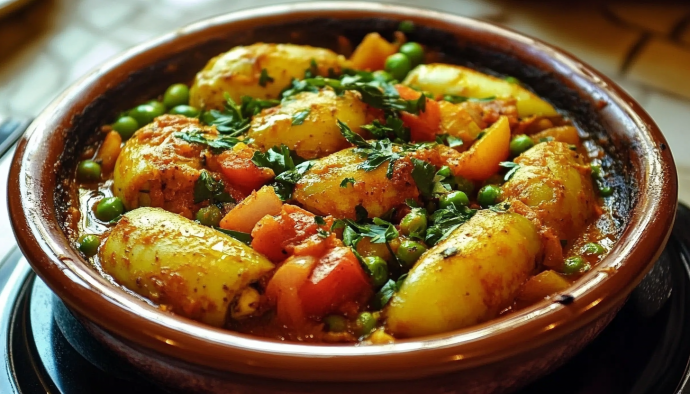
Types of Tagines: Chicken, Lamb, and Vegetarian Variations
- Moroccan food offers a variety of tagines, each reflecting the rich flavors of Morocco. Chicken tagine, often paired with olives and preserved lemons, is a beloved classic. Lamb tagine, slow-cooked with dried fruits and spices, brings depth and complexity. For a lighter option, vegetarian tagines combine seasonal vegetables and aromatic herbs, offering a fragrant taste of Moroccan tradition.
Cooking Techniques and Traditional Flavors
- Moroccan food is renowned for its slow-cooking techniques, which allow spices and ingredients to meld into rich, complex flavors. In Morocco, dishes like tagine and couscous are simmered over low heat to preserve their aromatic intensity. Traditional Moroccan flavors are rooted in the careful balance of spices, such as cumin, saffron, and cinnamon, creating a distinctive taste experience.
Couscous: Morocco’s Beloved Grain Dish
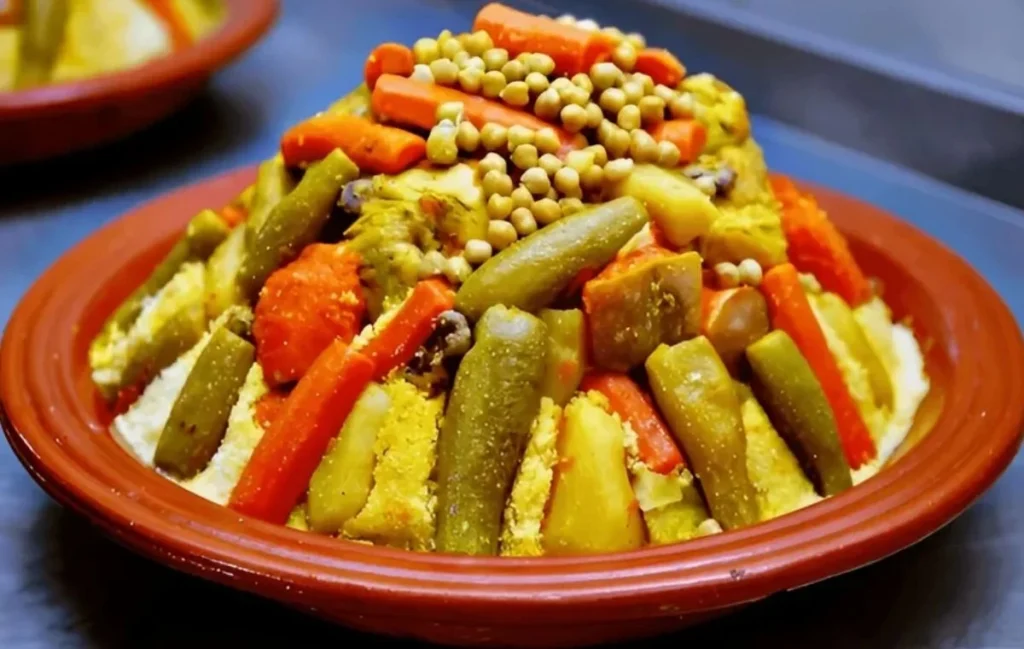
How Couscous is Made and Served
- Couscous, a staple of Moroccan food, is traditionally made by steaming fine semolina grains, ensuring a light, fluffy texture. In Morocco, it is often served with hearty stews or vegetables, absorbing rich flavors from the broth. Moroccan families typically gather to share this communal dish, showcasing the country’s emphasis on hospitality and the art of slow cooking.
Popular Couscous Dishes for Special Occasions
- In Moroccan food, couscous plays a central role during special occasions. Moroccan couscous with lamb, chicken, and vegetables is a popular celebratory dish, often served during religious holidays or family gatherings. In Morocco, couscous is sometimes prepared with dried fruits and nuts, adding sweetness and texture, making it a festive centerpiece that reflects the country’s culinary tradition.
Harira: The Iconic Moroccan Soup
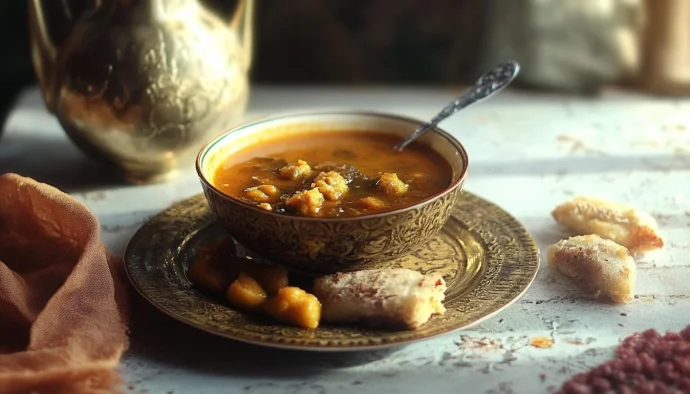
A Staple During Ramadan and Beyond
- In Moroccan food, couscous is a cherished staple, particularly during Ramadan. In Morocco, it is often enjoyed for Iftar, breaking the fast with a hearty, flavorful dish. While it holds special significance during the holy month, couscous continues to be a beloved meal year-round, symbolizing warmth, community, and the rich culinary heritage of Moroccan culture.
Key Ingredients and Regional Variations
- In Morocco, key ingredients like lamb, chicken, couscous, and vegetables are central to Moroccan food. Regional variations add unique flavors—coastal areas may feature fresh fish, while inland regions emphasize rich stews and hearty meats. Moroccan cuisine blends spices, like saffron and cumin, with fresh herbs, offering a diverse and vibrant culinary experience that reflects the country’s cultural heritage.
Pastilla: A Sweet and Savory Delight
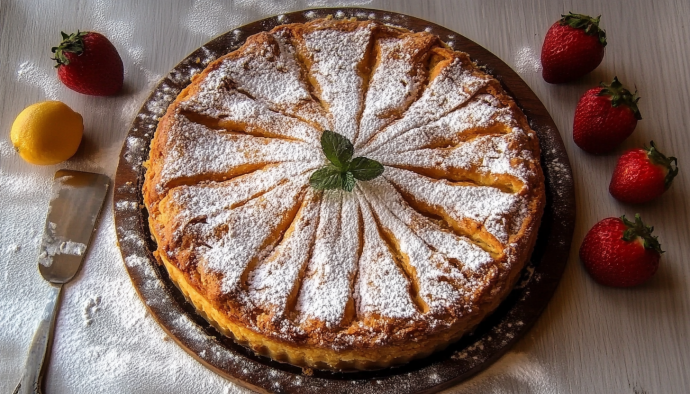
Layers of Flaky Pastry and Flavorful Filling
- In Morocco, pastries are a true art form. Moroccan food showcases delicate layers of flaky pastry, often filled with savory meats, nuts, or aromatic spices. These pastries embody the rich, complex flavors of Moroccan cuisine, offering a delightful contrast between crispy exterior and flavorful interior.
Traditional Ingredients and Modern Twists
- In Morocco, traditional ingredients like saffron, preserved lemons, and olives form the backbone of Moroccan food. While these staples remain beloved, chefs often incorporate modern twists, blending international influences with time-honored techniques. Moroccan cuisine continues to evolve, creating innovative dishes that honor its rich history while embracing contemporary flavors and textures.
Moroccan Mint Tea: A Cultural Ritual
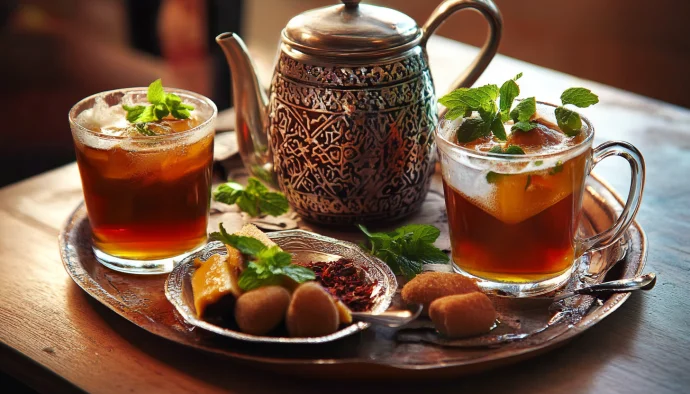
The Art of Brewing the Perfect Cup
- In Morocco, brewing the perfect cup of tea is an art form. Moroccan food culture revolves around the ritual of mint tea, prepared with precision and patience. The blend of green tea, fresh mint, and sugar is poured from a height to create a frothy finish, symbolizing hospitality and tradition in Moroccan life.
The Symbolism of Mint Tea in Moroccan Hospitality
- In Moroccan culture, mint tea is much more than a beverage; it is a symbol of warmth and hospitality. Serving Moroccan food and mint tea reflects generosity and respect for guests. The tea is prepared with care and served in ornate glasses, embodying tradition and connection within the vibrant social fabric of Moroccan life.
Tips for Experiencing Moroccan Food
Best Places to Try Authentic Moroccan Cuisine
To experience the true essence of Moroccan food, a visit to Morocco’s bustling souks and hidden gems is essential. Cities like Marrakech, Fes, and Casablanca offer some of the finest traditional dishes, where local vendors serve aromatic tagines and fresh couscous. For a deeper immersion, dining in the ancient riads provides an intimate taste of Moroccan heritage, while coastal areas like Essaouira present fresh seafood with a unique Moroccan twist. Each location promises a distinct culinary adventure.
How to Host a Moroccan-Themed Dinner at Home
Hosting a Moroccan-themed dinner at home involves vibrant decor, rich flavors, and an inviting atmosphere. Begin with a selection of classic Moroccan food like tagine, couscous, and fresh salads. Use intricate table settings with colorful ceramics and lanterns to set the scene. Serve dishes family-style, allowing guests to share and savor the communal experience. Complement the meal with Moroccan mint tea and spiced desserts like baklava. The key is to create a warm, festive environment full of authentic tastes and aromas.
Pairing Moroccan Dishes with the Right Drinks
Pairing Moroccan dishes with the right drinks elevates the dining experience. For savory stews like tagine, a glass of rich red wine complements the robust spices. Moroccan food also pairs wonderfully with mint tea, which cleanses the palate. For a lighter touch, fresh fruit juices, such as pomegranate or orange, provide a refreshing contrast to the rich flavors. The key is balancing the boldness of the spices with refreshing or bold beverages that enhance the meal’s complexity.
peo also
What is traditional moroccan food?
Moroccan food is a rich fusion of flavors, blending spices, herbs, and fresh ingredients. Staples like couscous, tagine, and harira embody the essence of Morocco’s culinary tradition, showcasing its cultural diversity and vibrant history. Moroccan dishes are truly a feast for the senses.
What food is known in Morocco?
Moroccan food is renowned for its bold flavors, with dishes like tagine, couscous, and pastilla. Morocco offers a unique culinary experience, featuring a vibrant mix of spices and fresh ingredients. Moroccan cuisine is a true reflection of its rich culture.
Why is Moroccan food famous?
Moroccan food is famous for its rich blend of spices, diverse flavors, and use of fresh ingredients. Morocco‘s unique culinary heritage, including tagine and couscous, has captivated food lovers worldwide. Moroccan cuisine offers an unforgettable taste experience.
What is street food in Morocco?
Moroccan food on the streets of Morocco is a vibrant experience. From savory moroccan sandwiches to grilled meats, and snacking on fresh olives, street food offers a delicious taste of local culture.
Embrace the Bold Flavors of Moroccan Cuisine
Pairing Moroccan food with the perfect drink enhances the meal’s depth. For hearty dishes like tagine, a full-bodied red wine complements the spices. Morocco‘s famed mint tea balances the richness of savory meals. Alternatively, refreshing fruit juices, such as pomegranate or orange, provide a zesty contrast, elevating the vibrant flavors of Moroccan cuisine.
Start Your Culinary Journey with These Top Picks
Embark on a flavorful adventure with these top Moroccan food picks. Start with a classic tagine, filled with aromatic spices and tender meat. Morocco offers a rich culinary heritage, where dishes like couscous and pastilla showcase bold flavors. Explore the diversity of Moroccan cuisine and awaken your taste buds.
Celebrate the Spirit of Morocco Through Its Food
Celebrate the spirit of Morocco through its vibrant and diverse Moroccan food. Each dish tells a story of rich heritage, from the comforting flavors of tagine to the aromatic spices of couscous. Moroccan cuisine invites you to explore its depth and culture, offering an unforgettable culinary journey.

